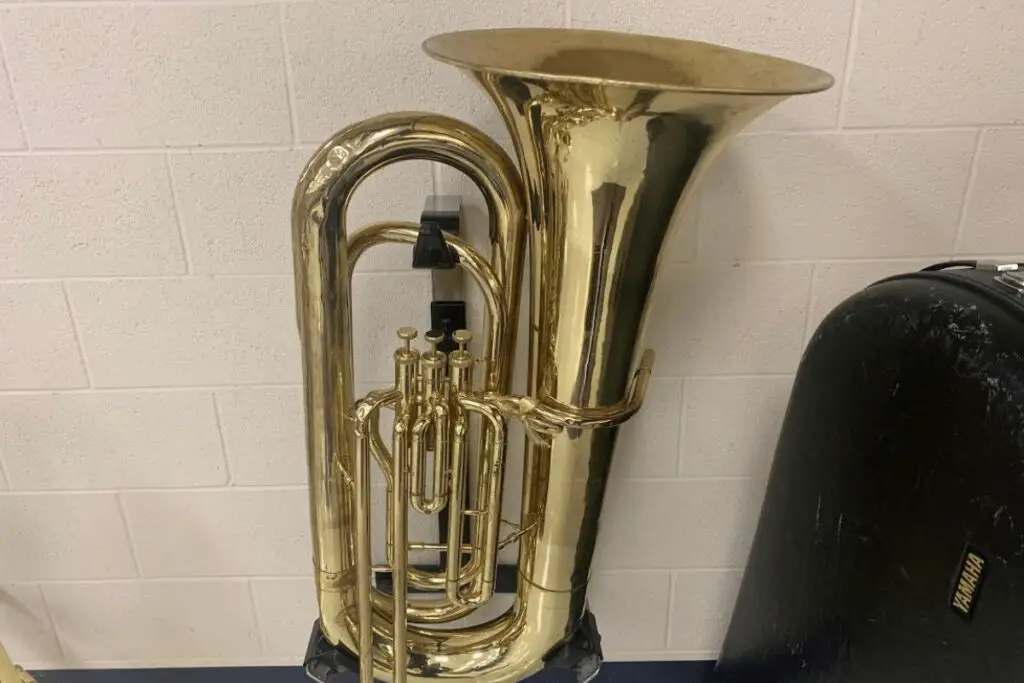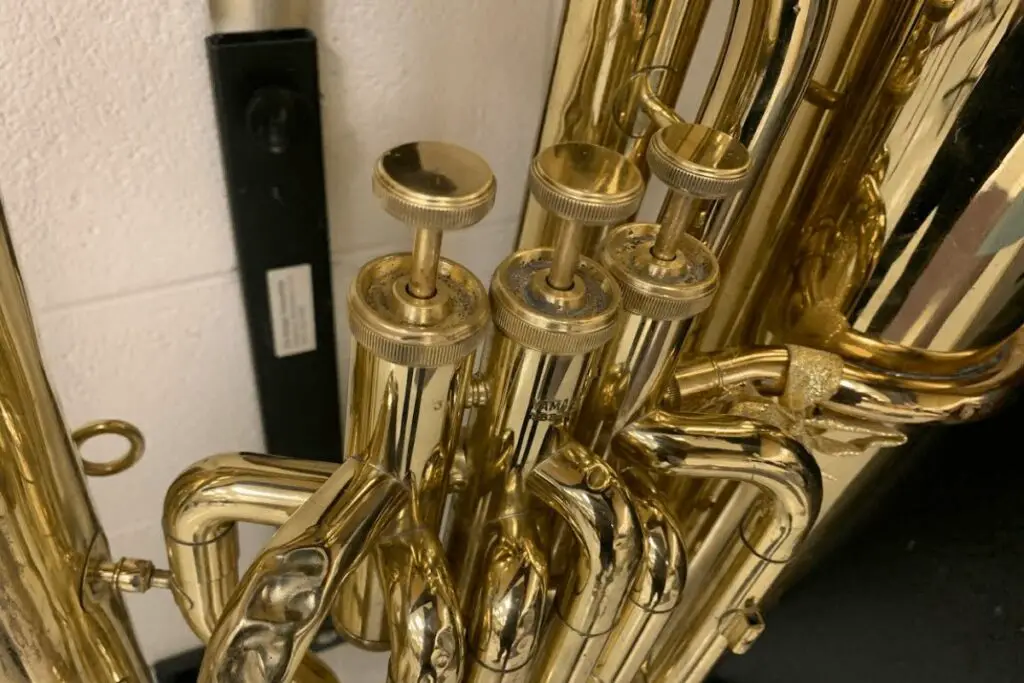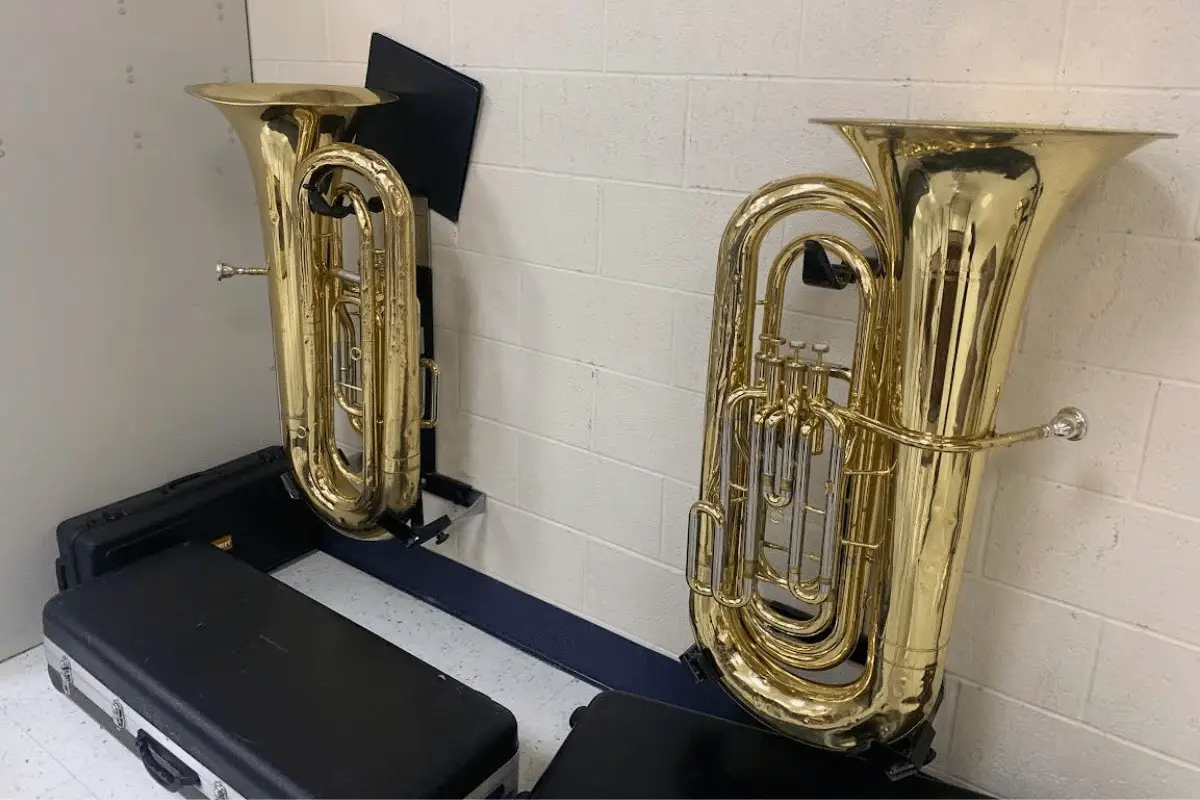The tuba is my bread and butter.
I have loved playing this instrument ever since I switched to it as my primary one in high school (around 20 years ago; yes, I’m old).
But when someone asked about the types of tubas out there, I needed to stop and count.
If I stretched the definition of tuba, I came up with 19 tuba types which I’ll talk about (and include some videos too).
Hey! If you like tuba stuff, check out my Instagram!
Table of Contents
Types Of Standard Tuba
The standard tubas come in four main keys.
None of these are transposing, so they all play the notes they read (concert pitch).
Let’s look at these types of tuba and where they show up.
BBb Tuba

BBb tubas are a type of contrabass tuba, and it’s the most common type of tuba out there.
Beginning band, high school, and most adult players who play the tuba use the BBb tuba (sometimes just called Bb tuba).
Its fundamental, or lowest pitch played with no valves pressed, is a Bb.
To be specific, it’s Bb1, which is 2 octaves and a major second below middle C or C4.
BBb tubas usually come with 3 or 4 valves, either rotary or piston, though most are piston.
They have 18′ feet of tubing.
Most tubas (including the other ones in this section) have their bells facing upward instead of forward.
Older tubas had forward-facing bells on occasion to help with recording equipment back in the day.
Modern tubas don’t need this anymore as the equipment has gotten better.
Bell-up tubas sound better as the articulation doesn’t sound right at you, and it allows the horn to better fill up a room.
CC Tuba
CC tubas are the next most common type of tuba.
Really good high school players and people who study at the college level, and professional tuba players use the CC tuba (often called a C tuba).
This tuba’s fundamental is C2, two octaves below middle C.
C tubas often have 4 or 5 valves (sometimes even 6!), and it’s more of an even mixture of rotary and piston valves.
CC tubas are preferred for the professional players because:
- The horns are usually made better.
- The fingering combinations work better across common keys in band and orchestra.
- It plays a little lighter than a BBb tuba.
This is the type of tuba I play, and my wife has one too!
We’re a two-tuba household!
F Tuba
F tubas are another common type, but this time you’ll mainly see them as solo tubas or in brass groups.
They are shorter in tubing and lighter than the BBb or CC tuba.
As such, they play higher and lighter, perfect for the faster notes required by tuba solos.
The fundamental of an F tuba is F2, an octave, and a fifth below middle C.
They usually come in 4 or 5 valves.
They’ll also rarely come with 6 valves.
For more examples of F tubas, check out this list of the best F tubas for all situations.
Eb Tuba
Eb tubas follow along the same lines as the F tuba.
It’s a horn that plays a little higher than the BBb or CC tuba but not quite as high as the F tuba.
Its fundamental pitch is Eb2, an octave and a major sixth below middle C.
Compared to the F tuba, it’s a major second below.
Eb tubas are more common as a solo tubas and in England-style brass bands.
In America, they’re still relatively few and far between.
Certain areas tend to have more, but this largely depends on the studio professor in the area.
Check out this list of famous tuba solos for some tuba inspiration.
Specialty Tubas
With these four main types of tubas out of the way, there are a few specialty tubas you may like to learn about.
All of these are variations on the main tuba, each with a specific job to do.
Sousaphone
The sousaphone, also known as a marching tuba, was invented by John Philip Sousa as a new type of tuba that worked better for marching.
It plays exactly like a BBb tuba, but it wraps around the player’s body and sits on their left shoulder.
The bell points forward to project the sound forward.
When you’re outside, an upward sound goes into the air.
It doesn’t bounce back like when you’re playing tuba inside.
Sousaphones are commonly found in marching bands, military bands, street bands, and mariachi.
Learn more in our article on sousaphone vs. tuba.
Fun fact: It was called the rain catcher at first because its bell faced up and resulted in gathering water when it rained!
Helicon
The Helicon was the precursor to the sousaphone.
It was the attempt to create a marching tuba that never really got off the ground in the mainstream band world.
Most of them are Bb instruments, but there were also some in the Eb, F, and tenor tuba range as well.
The Helicon wrapped around the player’s body in a circular motion, but the weight was too far forward to feel comfortable while marching.
It was mainly used in the 1860s for military bands and artillery-mounted bands in Central and Eastern Europe.
Helicons are still used in this area for folk music, but they aren’t used as much elsewhere, having been replaced by the sousaphone.
Some people called this the contrabass bugle.
Ophicleide
The ophicleide was used in the 1800s and was the precursor to the common tuba.
Its lifespan was limited, but it was one of the first experimentations to fulfill the low brass sounds the growing orchestras required.
The ophicleide was essentially a brass version of the bassoon.
It had a conical bore and featured many keys for changing notes like a woodwind instrument rather than the typical valves like the trumpets use.
Still, there were some famous parts in music of the time written to include the ophicleide.
Hector Berlioz’s Symphonie Fantastique even called for two of them!
Although, to be fair, this was because they were so inconsistent about playing the right notes that he figured if he used two of them, all the notes would get covered.
Plastic Tuba
There aren’t many plastic tubas around.
The main brand out there is Cool Wind.
As of now, this option is available for an affordable price in the BBb variety, though it features both pistons and rotary valves.
This is not intended to be a replacement for a “real” tuba, but it’s perfect for a practice horn.
Those who can’t drop the full price for a nice tuba (even used ones are expensive) can get a plastic one and get a lot of good out of playing it.
Read more in our detailed plastic tuba review.
Tuba Sizes
There are two main sizes of tuba, and it’s worth taking the time to talk about these sizes.
The terms are thrown around all the time, and it confuses people who don’t know what they mean.
Contrabass Tuba
Contrabass tubas are the most common types of modern tubas we use now.
The BBb and CC tubas are contrabass horns and larger tubas than their counterparts.
The reason they use two of the same letter is the indication that they aren’t just below middle C; they’re extra below it.
In older editions of pieces or those models of such pieces, they’ll often call for contrabass tuba.
While you can certainly play an Eb or F tuba with the part, a contrabass tuba part is meant for the fuller, richer sound of the BBb or CC tubas.
Contrabass is a term used in music to refer to instruments or parts that are mainly below the C2 octave.
Contrabass is also called a concert tuba.
Bass Tuba
Alternatively, bass tubas are the Eb and F tubas.
The term usually refers to an instrument or part playing below the C3 octave.
However, there is always confusion when people see bass tuba called for in a score.
If the piece was written recently (the past 50 years or so) or was written for high school or community bands, then even a bass tuba part is meant to be played on BBb tuba.
But if it was written before then, or the music stays in the upper part of the bass clef, then it really is calling for Eb tuba or F tuba.
Valve Types

There are two main types of valve types for tubas.
Even though the tubas themselves don’t change a lot depending on the valve design, there is enough of a distinction that rotary and piston valve tubas are marketed separately.
Piston Valves
Piston valves are what most people imagine when they think of valves.
These are like the valves you see on most trumpets.
They move up and down (thus the piston) to funnel air through different lengths of tubing to achieve different pitches.
Piston valves have two main things going for them:
- They’re super fast.
- They are super quiet.
Sounds perfect, right?
There are even many cases where piston valves lower the price of the brass instrument.
But they don’t work as consistently.
You need to oil them often, and if you press on them from an angle, they’ll bend slightly over time.
Once bent, they’ll be sticky no matter how many times you oil them.
It takes a repair to get it back to normal.
Rotary Valves
Rotary valves are the paddles you push, like on a French Horn.
These use levers to turn the valve chamber into different lengths of tubing.
As such, they work consistently and cleanly all the time with almost no maintenance.
I’ve gone literal years without needing to do much than oil my valves every month or so (even less when I’m not playing regularly).
However, the lever motion means it’s a little louder and not as quiet.
Still, the consistency is a huge draw for many players.
A good compromise some tuba designs follow is to use pistons for the four main valves (which allow for fast playing) and a rotary valve for the fifth (and sixth) one.
This still lets you get consistent low notes, which you may not be playing a lot, but you can still play fast for your higher notes using the four main valves.
Number Of Valves On A Tuba
Another way tubas are sorted by type is by the number of valves.
Tubas come in 3, 4, 5, and 6 valve types.
3 Valves
This is the standard for a beginner tuba and the sousaphone.
Any tuba that is even a little better than a beginner needs to have four valves.
Three-valve tubas don’t cut it.
The first valve lowers the fundamental pitch by two semitones or half steps.
The second valve lowers the fundamental by a single semitone or half step.
Pressing both of them down lowers your pitch three semitones.
This is also what the third valve does on its own.
3-valve tubas are limited in their low range, and their tuning as certain combinations (namely, 1-3 and 1-2-3) are often out of tune.
4 Valves
For most people who don’t pursue tuba in college or beyond, 4 valves are where you’ll want to live at.
4-valve tubas have access to most of the low notes a tuba part will call for, and you’ll avoid bad valve combinations for better tuning.
The fourth valve lowers the fundamental by five semitones; this is the same as pressing 1-3.
It only takes a simple switch, but to instantly sound better on the tuba, replace your 1-3 fingering with 4 and your 1-2-3 combination with 2-4.
This helps you play in tune quickly.
Sound better on the tuba with these tuba tips (expert approved!).
5 Valves
The fifth valve extends the range of the tuba down far beyond what it usually needs to play, but it’s great for providing more alternate fingerings to allow for both better tuning and faster playing.
On many tubas, the fifth valve is played with the thumb of the same hand as the other four valves.
The fifth valve isn’t standard on tubas.
My wife’s tuba and my tuba don’t play the same when we press our fifth valve.
It takes some experimenting to find out what it is and how it works, but this is part of what leads a player to enjoy their horn so much!
6 Valves
The sixth valve is usually played with the index finger of the opposite hand from the other valves.
Like the fifth valve, it isn’t standard in pitch, so you’ll need to play around to figure it out.
Most people agree the sixth valve is a bit overkill, but it serves the same purpose as the fifth, to add more low notes and alternate fingerings.
Tenor Tuba/Euphonium/Baritone Horn
The euphonium is often called the tenor tuba.
Many people put it in the tuba family because it was based on the tuba design.
However, it plays more like a trombone or tenor saxophone in terms of range and purpose in an ensemble.
Learn more in our euphonium, tuba, and baritone comparison guide.
Compensating Euphonium
A compensation euphonium is a special type of euph played by all professionals and many good high school players.
It’s hard to tell one just by looking at it.
On the euphonium lower notes, the notes tend to get sharp, even with the four valves.
Unlike the tuba (which has more tubing to work with) or the trumpet (with easily reachable slides), the euphonium can’t adjust as easily to flatten the notes.
A compensating horn uses a special system so that when they press the fourth valve down, the air is also redirected through an auxiliary set of tubes or slides also used as part of valves 1 and 3.
This lowers the pitch even further, making it just in tune.
Double Bell Euphonium
The Music Man musical famously calls for a double-belled euphonium, but has anyone ever seen one?
I’ve seen two, and they’re more of a novelty than anything practical.
One bell (the smaller) is cylindrical like a baritone or trombone and results in a brighter sound.
One bell (the larger) is a standard conical euphonium design and results in a lower sound.
The final valve (fourth or fifth, depending on the design) sends the sound through one bell or the other for a different timbre or tone.
This means the player can play either way and do some cool intentional effects with their brass instrument.
Marching Euphoniums
Marching euphoniums are designed just like normal ones, but they are wrapped, so they’re held like a trumpet.
This makes for a direct sound, better for the outdoors.
Marching euphoniums or marching baritones need to have strong arm muscles to hold their heavier instruments up to the proper horn angle.
Otherwise, it plays the same as a regular euphonium (though usually with more tuning and tone issues).

